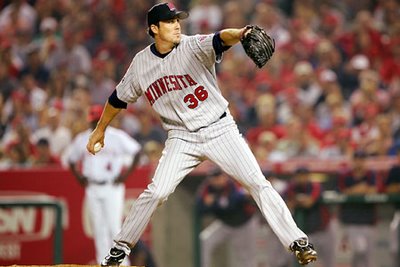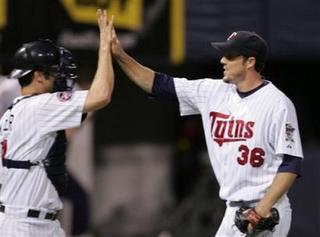March 24, 2008
Nathan Signs Extension
 Let's start with the negatives, because I'll be accused of focusing on that anyway. For a small-payroll team, there are better, more efficient ways to spend $12 million per season. Nathan has averaged 70 innings per year in Minnesota and the Twins' payroll figures to be around $80 million in 2009 before perhaps jumping as high as $90-$100 million in 2010 and 2011. That means the team will be devoting 12-15 percent of the budget to pay for about five percent of the innings throughout Nathan's deal.
Let's start with the negatives, because I'll be accused of focusing on that anyway. For a small-payroll team, there are better, more efficient ways to spend $12 million per season. Nathan has averaged 70 innings per year in Minnesota and the Twins' payroll figures to be around $80 million in 2009 before perhaps jumping as high as $90-$100 million in 2010 and 2011. That means the team will be devoting 12-15 percent of the budget to pay for about five percent of the innings throughout Nathan's deal.
Certainly Nathan's innings are more valuable than typical innings, but that has a lot to do with the role that he's asked to fill. From Rick Aguilera and Eddie Guardado to Nathan himself just four years ago, the Twins have shown that being an established closer isn't a prerequisite for being a successful closer. Like the majority of closers throughout baseball, Aguilera, Guardado, and Nathan were each former starters and middle relievers before the Twins made them into closers.
After acquiring him from the Giants the Twins gave Nathan a chance to replace Guardado as closer and four seasons later they're paying a premium to retain him because he succeeded in that role. In doing so they're paying not only for an elite reliever, but for an elite reliever who fills a very specific, value-inflating role. And the only reason that they're in a position to do so is because they chose not to pay that same premium for Guardado when he left as a free agent following the 2003 season.
Parting with Nathan would no doubt have been wildly unpopular with fans, but letting Guardado leave was plenty unpopular at the time and worked out well in the long term. When Guardado left the Twins he was the same age that Nathan is now and three years later he had broken down physically. The Twins could have taken draft picks when Nathan left via free agency, like they did by grabbing Glen Perkins with one of the selections that they received for Guardado.
Another option would have been trading Nathan for future help, which the Twins did twice with Aguilera, acquiring Kyle Lohse (among others). Instead of choosing either of those options while turning their attention to creating another closer, the Twins have chosen to commit a huge chunk of their payroll through 2011 for what will be at most 70 innings per season. I've long been of the opinion that 70 innings aren't worth 15 percent of a team's payroll regardless of how fantastic those 70 innings are.
The Twins' ability to build strong bullpens around cheap young arms and low-cost veterans--and specifically their recent history with closers--shows a big part of why that's the case. Beyond that, for the deal to even have a chance of working out in the Twins' favor Nathan clearly must continue to be an elite closer through the age of 36. While that's certainly possible, it's iffy given the risk of decline and injury associated with mid-30s pitchers. In fact, Nathan may have already shown a sign of decline.
From 2004-2006 he struck out 31.3, 34.1, and 36.3 percent of the batters he faced, but that fell to 27.3 percent last year. Even 27.3 percent is a great strikeout rate, but it represents a decline of 25 percent from the previous season and puts Nathan below the 30-percent mark for the first time since 2003. A small-payroll team committing $12 million per year to a closer guaranteed to be elite is questionable to begin with, but the absence of that guarantee is what really makes the deal dangerous.
None of which is a knock against Nathan. His role calls for him to pitch just 70 innings, but he does the job as well as anyone in baseball and certainly maximizes the value of those frames. In four years with the Twins he has a 1.94 ERA, 355-to-80 strikeout-to-walk ratio, and .185 opponent's batting average in 282.1 innings. His 160 saves during that span rank tied for the AL lead with Mariano Rivera and he converted 91.9 percent of his save opportunities to lead all of MLB.
 Nathan has essentially been as good as a closer can possibly be, which shows why the debate about the wisdom of signing him to a $47 million contract extension revolves primarily around the role rather than the player. If any 33-year-old, 70-inning relief pitcher is worth devoting one-seventh of the payroll to through 2011 it's Nathan, but that's a pretty big "if." With that said, Nathan's specific contract is relatively favorable for the Twins as far as $47 million contract extensions for relievers go.
Nathan has essentially been as good as a closer can possibly be, which shows why the debate about the wisdom of signing him to a $47 million contract extension revolves primarily around the role rather than the player. If any 33-year-old, 70-inning relief pitcher is worth devoting one-seventh of the payroll to through 2011 it's Nathan, but that's a pretty big "if." With that said, Nathan's specific contract is relatively favorable for the Twins as far as $47 million contract extensions for relievers go.
Instead of a standard deal with escalating salaries, the Twins took advantage of their current payroll surplus by tearing up his contract for 2008 and spreading the money out equally over four years. Rather than making $6 million in 2008 and an average of $14 million from 2009-2011, Nathan will make the same $11.25 million each year from 2008-2011. Nathan getting a 2008 bump from $6 million to $11.25 million is of little consequence given that the Twins still have over $10 million in unused payroll.
However, his making that same $11.25 million per year from 2009-2011--rather than $14 million or so--will give the Twins added payroll flexibility. Beyond that, the deal is truly a three-year extension with a team option for 2012, which is very different than the four-year extension that Nathan was previously said to be seeking. The Twins will have the option of buying him out for $2 million in 2012 and that's vastly different than being on the hook for another $12-$15 million during his age-37 season.
Of course, the three-year extension is essentially for $41 million--which works out to $13.67 million per season--and takes Nathan through his age-36 season, which is plenty risky anyway. At the end of the day I'd likely take a) two good prospects and $47 million to spend or b) one season of Nathan, two draft picks, and $41 million to spend over c) Nathan's next four seasons, but that has little to do with Nathan and everything to do with committing to a deal that at best will allow you to pay $170,000 per inning.
It's not a move that I'd have made given the Twins' payroll limitations and carries considerable risk while involving the most overrated "position" in baseball, but if any 33-year-old closer is worth locking up it's Nathan and the Twins did well to lessen the risk somewhat by spreading out the money equally. If he stays healthy and continues to dominate, the team will simply be paying a premium for a luxury and that's far from disastrous. If he gets hurt or merely declines in his mid-30s, that's another story.

